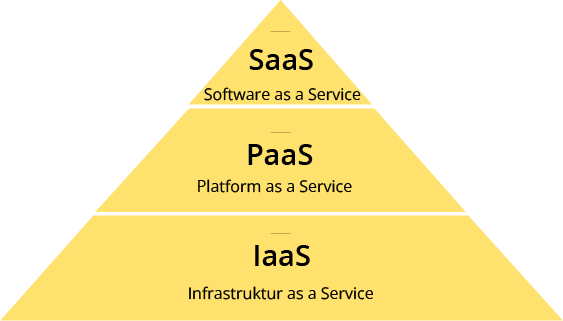Cloud solution
Limitless possibilities!
The term cloud or cloud computing describes an IT infrastructure consisting of several servers that are accessible via the internet or intranet and provide users with access to storage space, computing power or application software.
What is cloud computing?
Rapid scalability
Add or remove power within a very short time.
Sharing of resources
Many users share a large pool of resources. This enables flexible and cost-effective scaling.
Mandate capability
Data of the different users are separated from each other.
Consumption measurement
Performance-based and minute-by-minute billing.
Automation
Flexible scaling is only possible if the provider no longer has to intervene and the processes are automated.
Bandwidth
Only useful with sufficient bandwidth (> 10 Mbit/s) or with mobile broadband (3G/4G).
The current status
In everyday use, the term cloud has become synonymous with unlimited online storage where you can save your data and access it from any device and any location. But the cloud can do much more than just store data. In cloud computing, a distinction is made between infrastructure as a service (IaaS), platform as a service (PaaS) and software as a service (SaaS).

In terms of access forms, a distinction can be made here between the two extreme private clouds and the public cloud or the middle solution of the hybrid cloud.
Public Cloud
If a cloud from a public provider is accessible to everyone via the Internet, it is referred to as a public cloud. Due to the large number of providers, this model variant has a large portfolio of different offers that can be accessed without much effort. With this form of cloud, you share the services with other users and companies and only have limited customization options to meet your own needs. On the other hand, the use of many other users creates economies of scale, which in turn lead to lower prices in the applications. This also makes it possible to bill services to the minute, so that companies do not incur any costs for unused services.
Private cloud
In contrast to the public cloud, the private cloud is only accessible to a specific group of people. These cloud environments are often created by companies and only used by their own employees. The IT resources are located within the company and the cloud is behind the company's own firewall and can be used by employees via the intranet. This version has the typical advantages such as scalable IT structures or the option of running applications via the web browser without installation or maintenance. At the same time, however, the company must take over the IT structure and its maintenance itself.
Hybrid Cloud
The hybrid cloud is a hybrid form of public and private cloud that combines the advantages of both forms. In this model, business processes can be divided into two categories. Data protection-critical and non-critical processes. Depending on the subdivision of the process, they can now be assigned to the public or private cloud variant. Although this model variant includes all the advantages of public and private clouds, it also increases the complexity of the IT infrastructure and the management effort involved in administering this solution.
As an application example for cloud computing, a company could outsource many parts of its IT structure to the cloud. The cloud offers the possibility of calling up software that requires a powerful computer without the user even owning one. Smaller companies in particular can thus avoid expensive acquisition costs in the area of IT structure. There is no need for expensive and constantly growing server structures or IT staff to take care of their maintenance. Performance-based and minute-by-minute billing of the software used also ensures that the company only incurs costs when the services are actually used. In addition, accessibility via the Internet ensures that employees can interact with the services from the cloud in an agile manner, regardless of location.
Step-by-step introduction
Step 1: Determination of requirements
– Functional (e.g. what should the cloud solution be able to do?)
– Non-functional (e.g. technical and, above all, safety-related)
– Legal (e.g. data protection)
requirements must be clarified. All training requirements for employees must also be defined so that the switch to the new IT solution is possible.
With the help of this requirement profile, the providers can then be compared with each other in the next step.
Step 2: Selection
Another important aspect is the examination of cost-effectiveness and the associated assessment of whether the cloud solution unlocks potential and can generate benefits.
Step 3: Introduction
Opportunities for SMEs
Contact us
Keep an eye on the most important SME-relevant technologies with our technology radar!
